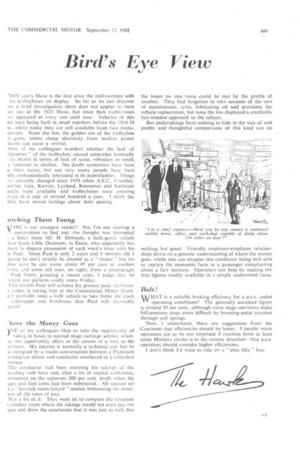Bird's Eye View
Page 111

If you've noticed an error in this article please click here to report it so we can fix it.
-1-115 veais Show is the first since the mid-twenties with no trolleybuses on display. So far as we can discover !om a brief investigation, there does not appear to have !en one at the 1923 Show, but since then trolleybuses Lye appeared at every one until now. Vehicles of this nd were being built in small .numbers before the 1914-18 ar, whilst today they are still available from two manucomers. None the less, the golden era of the trolleybus is gone, unless cheap electricity from nuclear power itions can cause a revival.
One of my colleagues wonders whether the lack of :haracter " of the trolleybus, caused somewhat ironically its merits in terms of lack of noise, vibration or smell, .s hastened its decline. No doubt economies have been
e main cause, but not very many people have been ally enthusiastically interested in its potentialities. Things ire certainly changed since 1939 when A.E.C.. Crossley, airnler, Guy, Karrier, Leyland, Ransomes and Sunbeam odds were available and trolley-buses were entering rvice at a rate of several hundred a year. I think the iblie have mixed feelings about their passing.
atching Them Young
v HO is our youngest reader? No, I'm not starting a I competition to find out; the thought was prompted f a letter from Mr. H. Debnam, a bulk-grain vehicle iver from Little Dunmow, in Essex, who apparently has most to dispute possession of each week's issue with his 4-1 Paul. Since Paul is only 2 years and 9 months old 1 .ppose he can't strictly be classed as a " reader' but his tiler says he can name about 95 per cent of modern rues, and some old ones, on sight; from a photograph Paul firmly grasping a recent copy, I judge that he !yours our pictures avidly every Friday.
This month Paul will achieve his present peak ambition: s rather is taking him to the Commercial Motor Show. e'll probably need a bulk vehicle to take home the stack catalogues and brochures that Paul will inevitably quire!
'here the Money Goes 1NE of my ,colleagues likes to take the opportunity of • riding in buses in normal stage carriage service, when'er the opportunity offers in the course of a visit to the (winces. His interest is normally a technical one but he s intrigued by a recent conversation between a Plymouth Jrporation driver and conductor overheard at a suburban rminus.
The conductor had been counting his takings of the !eceding rush hour and, after a bit of mental arithmetic, immented on the apparent 200 per cent. profit when the iges and fuel costs had been subtracted. All seemed set r a "barrack-room lawyer" session bemoaning the miseries; of the rates of pay.
Not a bit of it. They went on to compare the situation another route where the takings would not even pay the iges and drew the conclusion that it was just as well that
the losses on one route could be met by the profits of another. They had forgotten to take account of the cost of maintenance, tyres, lubricating oil and provision for vehicle replacement, but none the less displayed a creditably fair-minded approach to the subject.
But undertakings have nothing to hide in the way of vast profits and thoughtful comparisons of this kind can do
nothing but good. Friendly employer-employee relationships thrive on a genuine understanding of where the money goes, whilst one can imagine this conductor being well able to explain the economic facts to a passenger complaining about a fare increase. Operators can help by making the true figures readily available in a simply understood form.
Half!
WHAT is a suitable braking efficiency for a p.s.v. under
operating conditions? The generally accepted figure is around 50 per cent, although some stage operators make full-pressure stops more difficult by boosting pedal reaction through coil springs. Now, I understand, there are suggestions from the Continent that efficiencies should be lower. I hereby warn operators not to be too surprised if reaction from at least some Ministry circles is in the reverse direction—that p.s.v operators should consider higher efficiencies.
I don't think I'd want to ride on a "plus fifty" bus.










































































































































































































































































































































